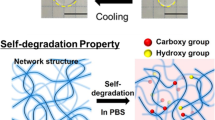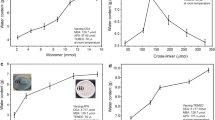Abstract
A novel polymeric hydrogel composed of hydroxyethyl cellulose-g-poly(2-hydroxyethyl methacrylate) was prepared via graft polymerization of hydroxyethyl methacrylate on the surface of hydroxyethyl cellulose. N,Nʹ-Methylenebisacrylamide was used as a cross-linker. In this work, we changed the ratio of hydroxyethyl cellulose to the monomer, while the potassium persulfate and the cross-liker were used in amounts proportional to the wt% of both the matrix and monomer. The copolymers formation was confirmed by infrared spectroscopy and X-ray diffraction pattern, while the changes in the surface morphology of the hydrogel were examined by scanning electron microscopy. The increase in the monomer ratio gradually improved the thermal stability of the resultant hydrogels. Finally, the cytotoxicity of the new polymeric hydrogels was evaluated using HCT-116, HepG2, MCF-7 human cancer cell lines and RPE-1 normal cell line. The cytotoxicity studies showed that the hydrogels were selectively toxic against the tested human cancer cell lines in a dose-dependent manner, whereas their cytotoxic activity was significantly reduced when they incubated with human RPE-1 normal cell lines, suggesting their possible utility in the formulation of anticancer drugs.






Similar content being viewed by others
References
Rodriguez CF, Bruneau N, Barra J, Alfonso D, Doelker E (2000) Hydrophilic cellulose derivatives as drug delivery carriers: influence of substitution type on the properties of the compressed matrix tablets. In: Wise DL (ed) Handbook of pharmaceutical controlled release technology. Dekker, New York, pp 1–30
Crabbe-Mann M, Tsaoulidis D, Parhizkar M, Edirisinghe M (2018) Ethyl cellulose, cellulose acetate and carboxymethyl cellulose microstructures prepared using electrohydrodynamics and green solvents. Cellulose 25(3):1687–1703
Chang C, Zhang L (2011) Cellulose-based hydrogels: present status and application prospects. Carbohyd Polym 84(1):40–53
Sood S, Gupta VK, Agarwal S, Dev K, Pathania D (2017) Controlled release of antibiotic amoxicillin drug using carboxymethyl cellulose-cl-poly (lactic acid-co-itaconic acid) hydrogel. Int J Biol Macromol 101:612–620
Rahmat D, Müller C, Barthelmes J, Shahnaz G, Martien R, Bernkop-Schnürch A (2013) Thiolated hydroxyethyl cellulose: design and in vitro evaluation of mucoadhesive and permeation enhancing nanoparticles. Eur J Pharm Biopharm 83(2):149–155
Guo Y, Zhang L, Li H, Han Y, Zhou J, Wang X (2016) Self-assembly and paclitaxel loading capacity of α-tocopherol succinate-conjugated hydroxyethyl cellulose nanomicelle. Colloid Polym Sci 294(1):135–143
Wang C, Tan H, Dong Y, Shao Z (2006) Trimethylsilyl hydroxypropyl cellulose: preparation, properties and as precursors to graft copolymerization of ε-caprolactone. React Funct Polym 66(10):1165–1173
Bagheri M, Shateri S, Niknejad H, Entezami AA (2014) Thermosensitive biotinylated hydroxypropyl cellulose-based polymer micelles as a nano-carrier for cancer-targeted drug delivery. J Polym Res 21(10):567–588
Hsieh MF, Van Cuong N, Chen CH, Chen YT, Yeh JM (2008) Nano-sized micelles of block copolymers of methoxy poly (ethylene glycol)-poly (ε-caprolactone)-graft-2-hydroxyethyl cellulose for doxorubicin delivery. J Nanosci Nanotechnol 8(5):2362–2368
El-Sayed NS, El-Sakhawy M, Hesemann P, Brun N, Kamel S (2018) Rational design of novel water-soluble ampholytic cellulose derivatives. Int J Biol Macromol 114:363–372
El-Sayed NS, El-Sakhawy M, Brun N, Hesemann P, Kamel S (2018) New approach for immobilization of 3-aminopropyltrimethoxysilane and TiO2 nanoparticles into cellulose for BJ1 skin cells proliferation. Carbohyd Polym 199:193–204
Peppas NA, Moynihan HJ, Lucht LM (1985) The structure of highly crosslinked poly(2-hydroxyethyl methacrylate) hydrogels. J Biomed Mater Res 19(4):397–411
Meiying L, Guangjian Z, Ke W, Qing W, Lei T, Xiaoyong Z, Yen W (2016) Recent developments in polydopamine: an emerging soft matter for surface modification and biomedical applications. Nanoscale 8:16819–16840
Horák D, Hlídková H, Hradil J, Lapčíková M, Šlouf M (2008) Superporous poly(2-hydroxyethyl methacrylate) based scaffolds: preparation and characterization. Polymer 49(8):2046–2054
Tomić SL, Mićić MM, Dobić SN, Filipović JM, Suljovrujić EH (2010) Smart poly(2-hydroxyethyl methacrylate/itaconic acid) hydrogels for biomedical application. Radiat Phys Chem 79(5):643–649
Kazemi AM, Zandi M, Shokrollahi P, Ehsani M, Baharvand H (2018) Surface modification of poly(2-hydroxyethyl methacrylate) hydrogel for contact lens application. Polym Adv Technol 29(4):1227–1233
Gao X, He C, Xiao C, Zhuang X, Chen X (2012) Synthesis and characterization of biodegradable pH-sensitive poly (acrylic acid) hydrogels crosslinked by 2-hydroxyethyl methacrylate modified poly (l-glutamic acid). Mater Lett 77:74–77
Macková H, Plichta Z, Proks V, Kotelnikov I, Kučka J, Hlídková H, Jiráková K (2016) Modified superporous poly(2-hydroxyethyl methacrylate) scaffolds for tissue engineering applications. Macromol Biosci 16(11):1621–1631
Cetin D, Kahraman AS, Gumusderelioglu M (2011) Novel scaffolds based on poly(2-hydroxyethyl methacrylate) superporous hydrogels for bone tissue engineering. J Biomater Sci Polym Ed 22(9):1157–1178
Kondiah PJ, Choonara YE, Kondiah PPD, Marimuthu T, Kumar P, du Toit LC, Pillay V (2016) A review of injectable polymeric hydrogel systems for application in bone tissue engineering. Molecules 21(11):1580–1592
Figueiredo AGPR, Figueiredo ARP, Alonso-Varona A, Fernandes SCM, Palomares T, Rubio-Azpeitia E, Freire CSR (2013) Biocompatible bacterial cellulose-poly(2-hydroxyethyl methacrylate) nanocomposite films. Biomed Res Int 2013, 698141
Joshi JM, Sinha VK (2006) Graft copolymerization of 2-hydroxyethylmethacrylate onto carboxymethyl chitosan using CAN as an initiator. Polymer 47(6):2198–2204
Pandey S, Mishra SB (2011) Graft copolymerization of ethylacrylate onto xanthan gum, using potassium peroxydisulfate as an initiator. Int J Biol Macromol 49(4):527–535
Li X, Sun Q, Li Q, Kawazoe N, Chen G (2018) Functional hydrogels with tunable structures and properties for tissue engineering applications. Front Chem 6:499–499
Chen K, Fan X, Tang K, Wan G, He X, Li X, Wang F (2018) Morphology-controllable collagen/poly(2-hydroxyethyl methacrylate) porous hydrogel with a paraffin microsphere as a template. ACS Appl Bio Mater 1(5):1311–1318
dos Santos JFR, Couceiro R, Concheiro A, Torres-Labandeira JJ, Alvarez-Lorenzo C (2008) Poly (hydroxyethyl methacrylate-co-methacrylated-β-cyclodextrin) hydrogels: synthesis, cytocompatibility, mechanical properties and drug loading/release properties. Acta Biomater 4(3):745–755
Das D, Das R, Ghosh P, Dhara S, Panda AB, Pal S (2013) Dextrin cross linked with poly(HEMA): a novel hydrogel for colon specific delivery of ornidazole. RSC Adv 3(47):25340–25350
Das D, Pal S (2015) Dextrin/poly (HEMA): pH responsive porous hydrogel for controlled release of ciprofloxacin. Int J Biol Macromol 72:171–178
Zi L, Meiying L, Ke W, Fengjie D, Dazhuang X, Liangji L, Yiqun W, Xiaoyong Z, Yen W (2016) Facile synthesis of AIE-active amphiphilic polymers: self-assembly and biological imaging applications. Mater Sci Eng, C 66:215–220
Zi L, Meiying L, Ruming J, Qing W, Liucheng M, Yiqun W, Fengjie D, Xiaoyong Z, Yen W (2017) Preparation of water soluble and biocompatible AIE-active fluorescent organic nanoparticles via multicomponent reaction and their biological imaging capability. Chem Eng J 308:527–534
Xiaoyong Z, Xiqi Z, Bin Y, Meiying L, Wanyun L, Yiwang C, Yen W (2014) Polymerizable aggregation-induced emission dye-based fluorescent nanoparticles for cell imaging applications. Polym Chem 5:356–360
Long H, Saijiao Y, Junyu C, Jianwen T, Qiang H, Hongye H, Yuanqing W, Fengjie D, Xiaoyong Z, Yen W (2019) A facile surface modification strategy for fabrication of fluorescent silica nanoparticles with the aggregation-induced emission dye through surface initiated cationic ring opening polymerization. Mater Sci Eng, C 94:270–278
Emam AN, Loutfy SA, Mostafa AA, Awad H, Mohamed MB (2017) Cyto-toxicity, biocompatibility and cellular response of carbon dots–plasmonic based nano-hybrids for bioimaging. RSC Advances 7(38):23502–23514
Xiaoyong Z, Qiang H, Fengjie D, Hongye H, Qing W, Meiying L, Yen W (2017) Review Mussel-inspired fabrication of functional materials and their environmental applications: progress and prospects. Appl Mater Today 7:222–238
Qiang H, Jiao Z, Meiying L, Yan L, Jiayuan R, Qing L, Jianwen T, Xiaoli Z, Xiaoyong Z, Yen W (2018) Synthesis of polyacrylamide immobilized molybdenum disulfide (MoS 2 @PDA@PAM) composites via mussel-inspired chemistry and surface-initiated atom transfer radical polymerization for removal of copper (II) ions. J Taiwan Inst Chem Eng 86:174–184
Junyu C, Meiying L, Qiang H, Long H, Hongye H, Fengjie D, Yuanqing W, Jianwen T, Xiaoyong Z, Yen W (2018) Facile preparation of fluorescent nanodiamond-based polymer composites through a metal-free photo-initiated RAFT process and their cellular imaging. Chem Eng J 337:82–90
Rao KM, Nagappan S, Seo DJ, Ha CS (2014) pH sensitive halloysite-sodium hyaluronate/poly(hydroxyethyl methacrylate) nanocomposites for colon cancer drug delivery. Appl Clay Sci 97:9833–9842
Mansfield EDH, Pandya Y, Mun EA, Rogers SE, Abutbul-Ionita I, Danino D, Khutoryanskiy V (2018) Structure and characterisation of hydroxyethylcellulose–silica nanoparticles. RSC Adv 8(12):6471–6478
Wang W, Wang J, Kang Y, Wang A (2011) Synthesis, swelling and responsive properties of a new composite hydrogel based on hydroxyethyl cellulose and medicinal stone. Compos B Eng 42(4):809–818
Roorda WE, Bouwstra JA, de Vries MA, Junginger HE (1988) Thermal analysis of water in p(HEMA) hydrogels. Biomaterials 9(6):494–499
Ray J, Jana S, Tripathy T (2018) Synthesis of dipolar grafted hydroxyethyl cellulose and its application for the removal of phosphate ion from aqueous medium by adsorption. Int J Biol Macromol 109:492–506
Acknowledgements
The authors gratefully acknowledge the National Research Centre (NRC) (Grant No. AR11040), Egypt, for financial support.
Author information
Authors and Affiliations
Corresponding author
Ethics declarations
Conflict of interest
The authors declare that there is no conflict of interests in the results reported in the present paper.
Additional information
Publisher's Note
Springer Nature remains neutral with regard to jurisdictional claims in published maps and institutional affiliations.
Rights and permissions
About this article
Cite this article
El-Sayed, N.S., Awad, H., El-Sayed, G.M. et al. Synthesis and characterization of biocompatible hydrogel based on hydroxyethyl cellulose-g-poly(hydroxyethyl methacrylate). Polym. Bull. 77, 6333–6347 (2020). https://doi.org/10.1007/s00289-019-02962-1
Received:
Revised:
Accepted:
Published:
Issue Date:
DOI: https://doi.org/10.1007/s00289-019-02962-1




